Thermal Performance Optimization and Experimental Evaluation of Vacuum-Glazed Windows Manufactured via the In-Vacuum Method
Abstract
:1. Introduction
2. Performance of Vacuum-Glazed Windows
3. Materials and Methods
3.1. Vacuum Glazing Manufacturing Technology
3.1.1. Vacuum Glazing Manufacturing by the Pumping Decompression Method
3.1.2. Vacuum Glazing Manufacturing Technology via the In-Vacuum Method
3.1.3. Characteristics of the Vacuum Glazing Produced by the In-Vacuum Method
3.2. How to Assess the Insulation Performance of Vacuum Multi-Layer Glass
4. Results
4.1. Thermal Performance Optimization according to the Vacuum Multi-Layer Glass Construction Method
U-value of the Vacuum Multi-Layer Glass According to the Pillar Spacing
4.2. U-value of the Vacuum Glazing According to the Low-e Coating Location
4.3. U-value of the Vacuum Multi-Layer Glass According to the Frame Type
4.4. Thermal Performance Comparison between Vacuum-Glazed Windows and Triple-Glazed Windows through Building Application
4.4.1. Thermal Performance Comparison Experiment Methods
4.4.2. Results of the heat flow comparison experiment
4.4.3. Results of the Surface Temperature Comparison Experiment
5. Conclusion and Discussion
- To optimize the pillar spacing, the U-value was measured, and the results were compared for pillar spacings of 25, 30, 40, and 50 mm. The experimental results showed that the performance of the vacuum glazing varied significantly depending on the number of pillars due to the pillar spacing and that the insulation performance of the vacuum multi-layer glass significantly changed in proportion to the heat transfer area. The optimal pillar spacing was found to be 40 mm, considering the structural stability and insulation performance.
- To optimize the low-e coating application locations, the U-values of the vacuum glazing with the low-e coating located on the inner surface of the glass on the outdoor side (LE-2) and the vacuum glazing with low-e coating located on the inner surface of the glass on the indoor side (LE-5) were measured and compared. The results were compared with those of the vacuum glazing without low-e coating (LE-0). The experimental results showed that the U-value of LE-5 (0.428 W/m2K) was approximately 69% and 75% lower than those of LE-0 (1.711 W/m2K) and LE-2 (1.369 W/m2K), respectively. Therefore, the low-e coating surface, when it is applied, must be used inside the vacuum layer to maximize insulation performance.
- When the pillar spacing was 40 mm and the LE-5 vacuum multi-layer glass was produced using the in-vacuum method, the insulation performance (i.e., U-value) according to the frame type was found to be 0.886 W/m2K when the thermally broken aluminum frame was applied and 0.69 W/m2K when the PVC frame was applied.
- The heat flow measurement results showed that the heat flow of the vacuum glazing ranged from 0.3 to 0.5 W/m2K, while that of the triple glazing ranged from 1.0 to 1.5 W/m2K, during the experimental period. Throughout the night, the triple glazing discharged approximately 0.8 W/m2K more heat to the outside than did the vacuum glazing. This indicated that the insulation performance of the vacuum-glazed window was superior.
- The surface temperature measurement results showed that the maximum indoor and outdoor surface temperature difference was 35.1 °C for the vacuum-glazed window and 23.1 °C for the triple-glazed window, confirming that the center-of-glazing thermal performance of the vacuum-glazed window was excellent. Moreover, the vacuum glazing exhibited 5.3–5.8 °C higher average surface temperatures at the edges than did the triple glazing.
Author Contributions
Funding
Conflicts of Interest
References
- Baetens, R.; Jelle, B.P.; Gustavsen, A. Aerogel insulation for building applications: A state-of-the-art review. Energy Build. 2011, 43, 761–769. [Google Scholar] [CrossRef]
- Jelle, B.P.; Hynd, A.; Gustavsen, A.; Arasteh, D.; Goudey, H.; Hart, R. Fenestration of today and tomorrow: A state-of-the-art review and future research opportunities. Sol. Energy Mater. Sol. Cells 2012, 96, 1–28. [Google Scholar] [CrossRef] [Green Version]
- Gustavsen, A.; Jelle, B.P.; Arasteh, D.; Kohler, K. State-of-the-Art Highly Insulating Window Frames. Res. Mark. Rev. 2007, 2, 6–7. [Google Scholar]
- Hu, D.; Li, Y.; Liu, C.; Li, Y. Analysis for the heat transfer of fully tempered vacuum glazing based on the thermal resistance model and finite element model. Adv. Mech. Eng. 2018, 10, 168781401879598. [Google Scholar] [CrossRef]
- Tällberg, R.; Jelle, B.P.; Loonen, R.; Gao, T.; Hamdy, M. Comparison of the energy saving potential of adaptive and controllable smart windows: A state-of-the-art review and simulation studies of thermochromic, photochromic and electrochromic technologies. Sol. Energy Mater. Sol. Cells 2019, 200, 109828. [Google Scholar] [CrossRef] [Green Version]
- van Esch, E.; Minjock, R.; Colarelli, S.M.; Hirsch, S. Office window views: View features trump nature in predicting employee well-being. J. Environ. Psychol. 2019, 64, 56–64. [Google Scholar] [CrossRef]
- Farley, K.M.; Veitch, J.A. A Room with a View: A review of the Effects of Windows on Work and Well-Being; IRC: New York, NY, USA, 2001. [Google Scholar]
- Tahmasebi, M.M.; Banihashemi, S.; Hassanabadi, M.S. Assessment of the Variation Impacts of Window on Energy Consumption and Carbon Footprint. Procedia Eng. 2011, 21, 820–828. [Google Scholar] [CrossRef] [Green Version]
- Sadrzadehrafiei, S.; Sopian, K.S.M.; Lim, C. Potential energy and emission reduction through application of triple glazing. In Proceedings of the 6th International Conference on Energy and Development—Environment—Biomedicine (EDEB’12), Athens, Greece, 7–9 March 2012; pp. 138–142. [Google Scholar]
- Jaber, S.; Ajib, S. Thermal and economic windows design for different climate zones. Energy Build. 2011, 43, 3208–3215. [Google Scholar] [CrossRef]
- Werner, A.; Roos, A. Simulations of coatings to avoid external condensation on low U-value windows. Opt. Mater. 2008, 30, 968–978. [Google Scholar] [CrossRef]
- Garrison, J.D.; Collins, R.E. Manufacture and cost of vacuum glazing. Sol. Energy 1995, 55, 151–161. [Google Scholar] [CrossRef]
- Fang, Y.; Eames, P.C. The effect of glass coating emittance and frame rebate on heat transfer through vacuum and electrochromic vacuum glazed windows. Sol. Energy Mater. Sol. Cells 2006, 90, 2683–2695. [Google Scholar] [CrossRef]
- Fang, Y.; Hyde, T.J.; Arya, F.; Hewitt, N.; Wang, R.; Dai, Y. Enhancing the thermal performance of triple vacuum glazing with low-emittance coatings. Energy Build. 2018, 97, 186–195. [Google Scholar] [CrossRef]
- Eames, P.C. Vacuum glazing: Current performance and future prospects. Vacuum 2008, 82, 717–722. [Google Scholar] [CrossRef]
- Cho, S.; Kim, S.H. Analysis of the Performance of Vacuum Glazing in Office Buildings in Korea: Simulation and Experimental Studies. Sustainability 2017, 9, 936. [Google Scholar] [CrossRef]
- Fang, Y.; Arya, F. Evacuated glazing with tempered glass. Sol. Energy 2019, 183, 240–247. [Google Scholar] [CrossRef]
- Memon, S.; Farukh, F.; Kandan, K. Effect of cavity vacuum pressure diminution on thermal performance of triple vacuum glazing. Appl. Sci. 2018, 8, 1705. [Google Scholar] [CrossRef]
- Simko, T.; Collins, R.; Beck, F.A.; Arasteh, D. Edge Conduction in Vacuum Glazing; LBNL Publications: Berkeley, CA, USA, 1995.
- Manz, H. On minimizing heat transport in architectural glazing. Renew. Energy 2008, 33, 119–128. [Google Scholar] [CrossRef]
- Memon, S. Investigating Energy Saving Performance Interdependencies with Retrofit Triple Vacuum Glazing for Use in UK Dwelling with Solid Walls; London South Bank University: London, UK, 2015. [Google Scholar]
- Kim, S.C.; Yoon, J.H.; Lee, R.D. Energy Performance Assessment of a 2nd-Generation Vacuum Double Glazing Depending on Vacuum Layer Position and Building Type in South Korea. Energies 2017, 10, 1240. [Google Scholar]
- Ghosh, A.; Sundaram, S.; Mallick, T.K. Investigation of thermal and electrical performances of a combined semi-transparent PV-vacuum glazing. Appl. Energy 2018, 228, 1591–1600. [Google Scholar] [CrossRef]
- Qiu, C.; Yang, H.; Sun, H. Investigation on the thermal performance of a novel vacuum PV glazing in different climates. Energy Procedia 2019, 158, 706–711. [Google Scholar] [CrossRef]
- Ghosh, A.; Sundaram, S.; Mallick, T.K. Colour properties and glazing factors evaluation of multicrystalline based semi-transparent Photovoltaic-vacuum glazing for BIPV application. Renew. Energy 2019, 131, 730–736. [Google Scholar] [CrossRef]
- Qiu, C.; Yang, H.; Zhang, W. Investigation on the energy performance of a novel semi-transparent BIPV system integrated with vacuum glazing. In Building Simulation; Tsinghua University Press: Beijing, China, 2019; Volume 12, pp. 29–39. [Google Scholar]
- Wullschleger, L.; Manz, H.; Wakili, K.G. Finite element analysis of temperature-induced deflection of vacuum glazing. Constr. Build. Mater. 2009, 23, 1378–1388. [Google Scholar] [CrossRef]
- Bao, M.; Liu, X.; Yang, J.; Bao, Y. Novel hybrid vacuum/triple glazing units with pressure equalisation design. Constr. Build. Mater. 2017, 73, 645–651. [Google Scholar] [CrossRef]
- Griffiths, P.W.; di Leo, M.; Cartwright, P.; Eames, P.C.; Yianoulis, P.; Leftheriotis, G.; Norton, B. Fabrication of evacuated glazing at low temperature. Sol. Energy 1998, 63, 243–249. [Google Scholar] [CrossRef]
- Papaefthimiou, S.; Leftheriotis, G.; Yianoulis, P.; Hyde, T.; Eames, P.C.; Fang, Y.; Jannasch, P.; Pennarun, P.-Y. Development of electrochromic evacuated advanced glazing. Energy Build. 2006, 38, 1455–1467. [Google Scholar] [CrossRef]
- Lenzen, M.; Collins, R.E. Long-term field tests of vacuum glazing. Sol. Energy 1997, 61, 11–15. [Google Scholar] [CrossRef]
- Fang, Y.; Eames, P.C.; Norton, B.; Hyde, T.J. Experimental validation of a numerical model for heat transfer in vacuum glazing. Sol. Energy 2006, 80, 564–577. [Google Scholar] [CrossRef]
- Simko, T.; Collins, R.E. Vacuum glazing: Development, design challenges and commercialization. Aust. J. Mech. Eng. 2014, 12, 305–316. [Google Scholar] [CrossRef]
- Zhao, J.F.; Eames, P.C.; Hyde, T.J.; Fang, Y.; Wang, J. A modified pump-out technique used for fabrication of low temperature metal sealed vacuum glazing. Sol. Energy 2007, 81, 1072–1077. [Google Scholar] [CrossRef]
- Bienvenido-Huertas, D.; Rodríguez-Álvaro, R.; Moyano, J.; Rico, F.; Marín, D. Determining the U-Value of Façades Using the Thermometric Method: Potentials and Limitations. Energies 2018, 11, 360. [Google Scholar] [CrossRef]
- ISO. Part 1: Complete windows and doors. In Thermal Performance of Windows and Doors—Determination of Thermal Transmittance by the Hot-Box Method; ISO 12567-1:2010; ISO: Geneva, Switzerland, 2010. [Google Scholar]
- National Fenestration Rating Council. Procedure for Determining Fenestration Product U-factors (ANSI/NFRC 100-2014); National Fenestration Rating Council: Greenbelt, MD, USA, 2014. [Google Scholar]
- ISO. Part 1: Heat flow meter method. In Thermal Insulation—Building Elements—In-Situ Measurement of Thermal Resistance and Thermal Transmittance; ISO 9869-1:2014; ISO: Geneva, Switzerland, 2014. [Google Scholar]

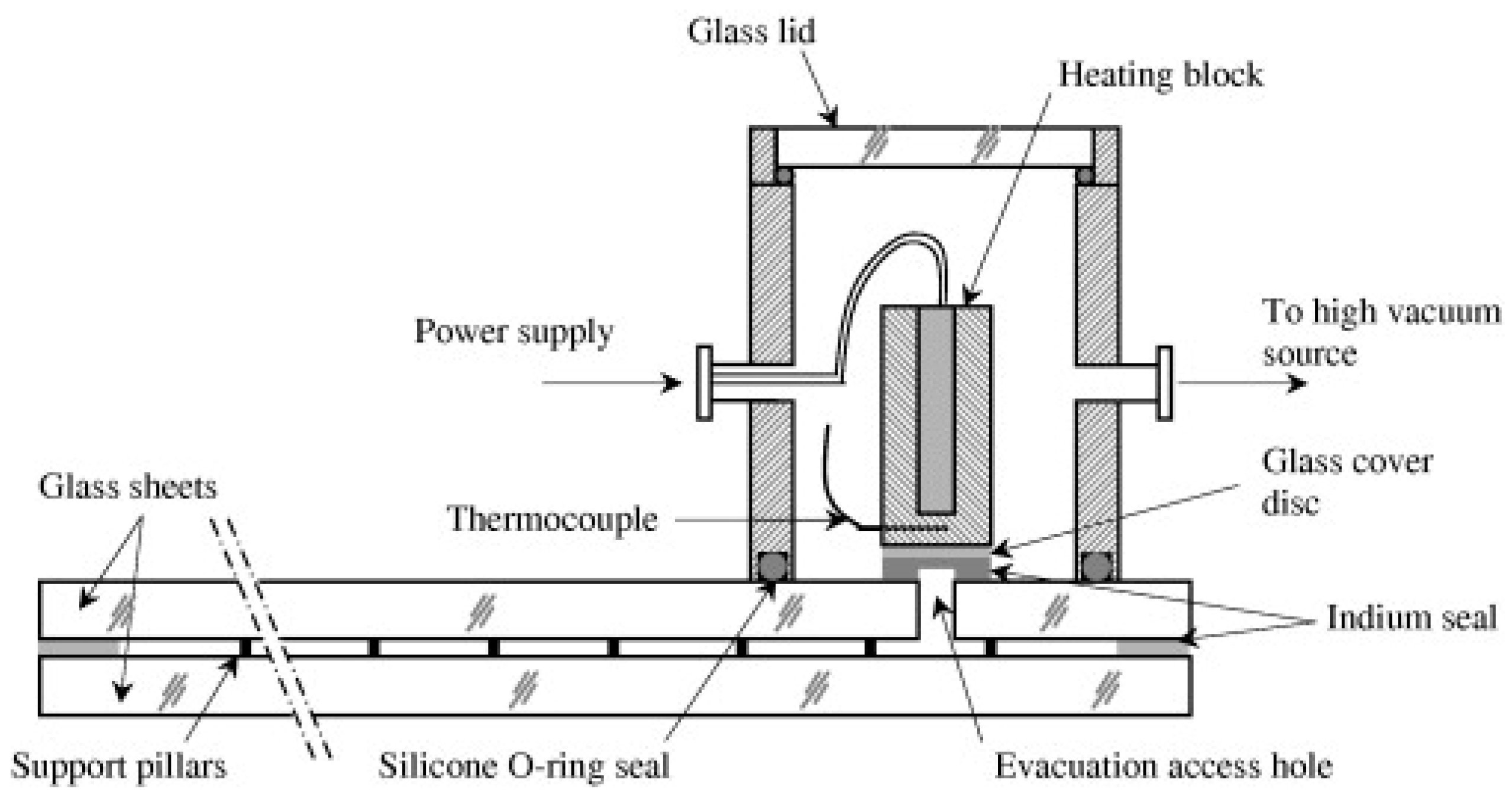


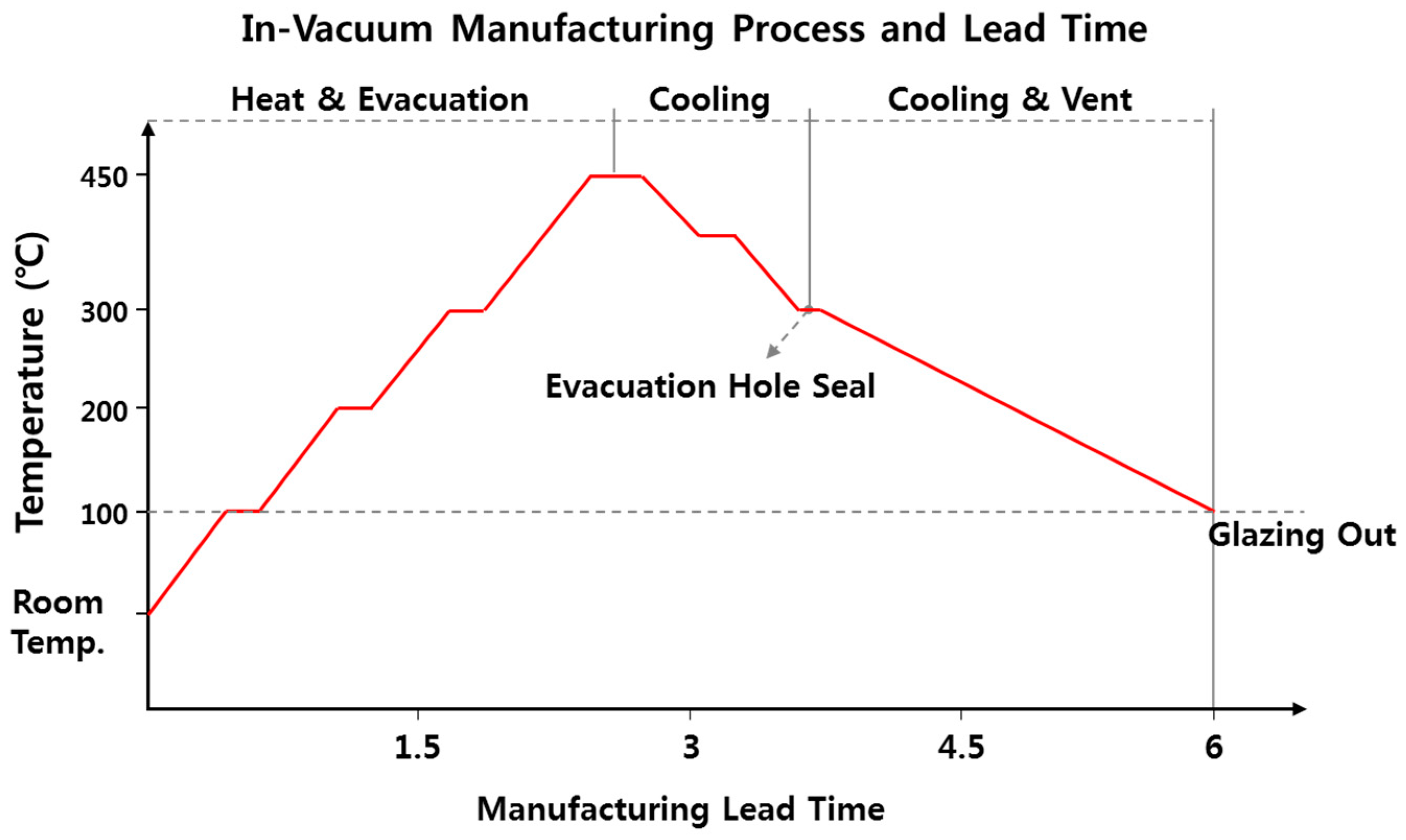
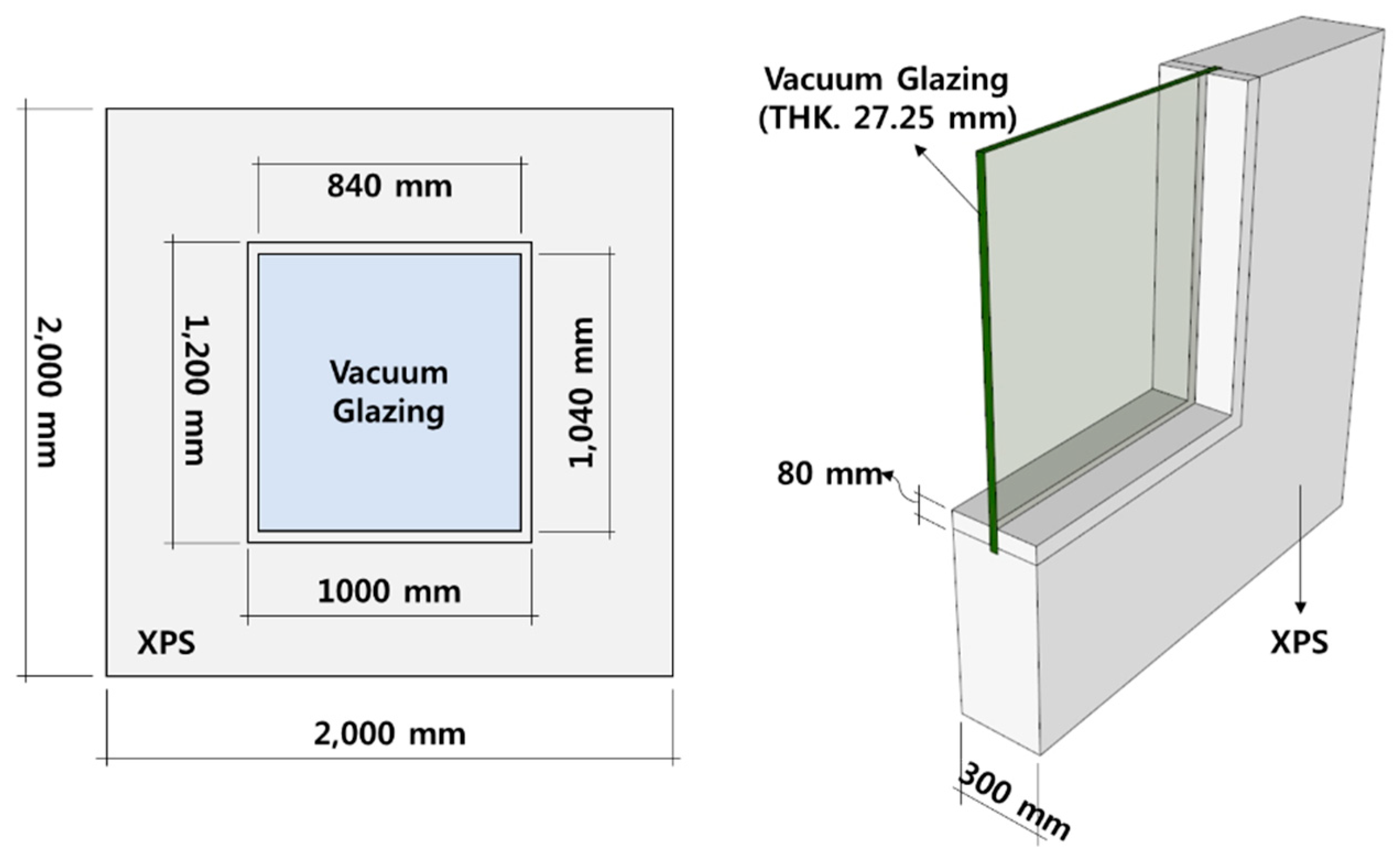

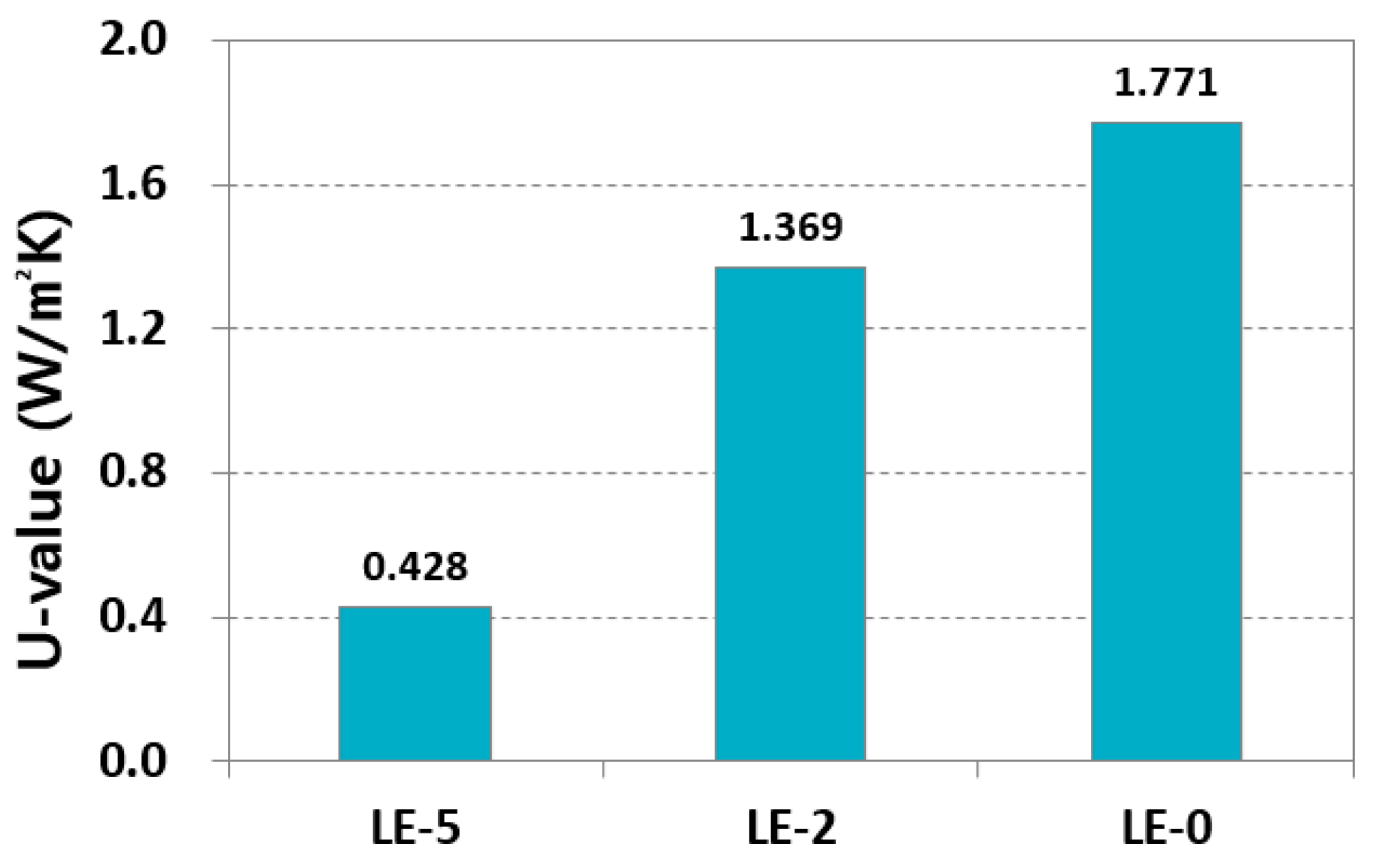
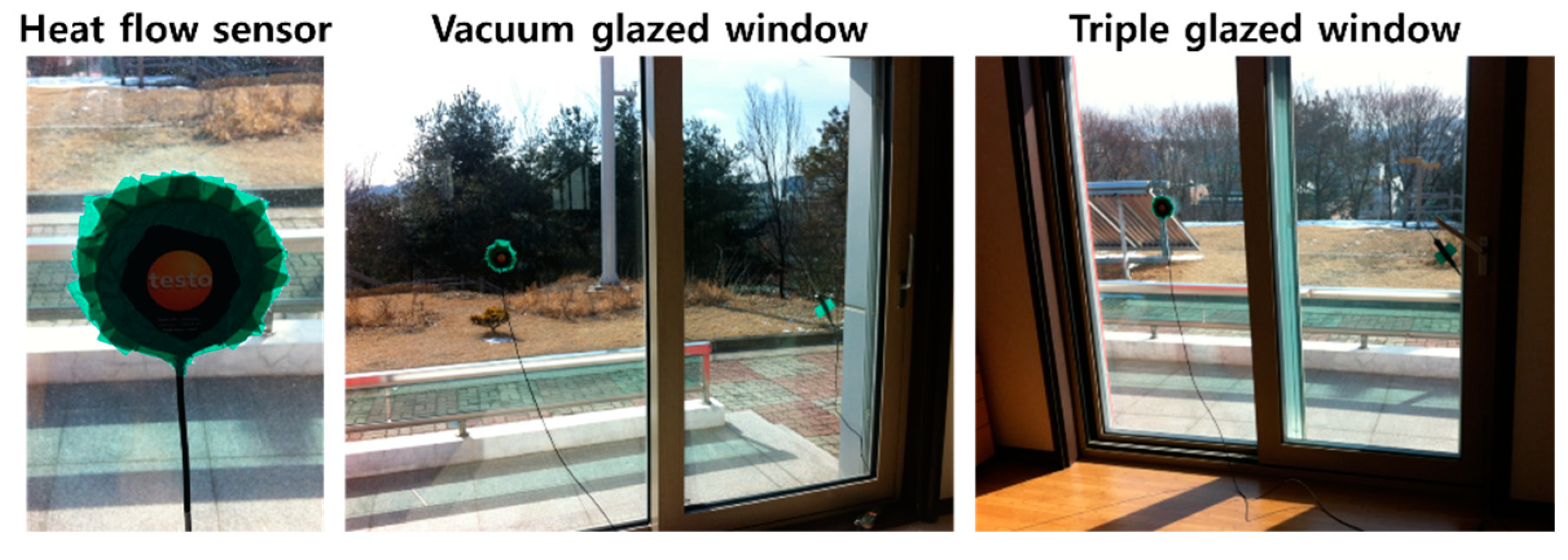
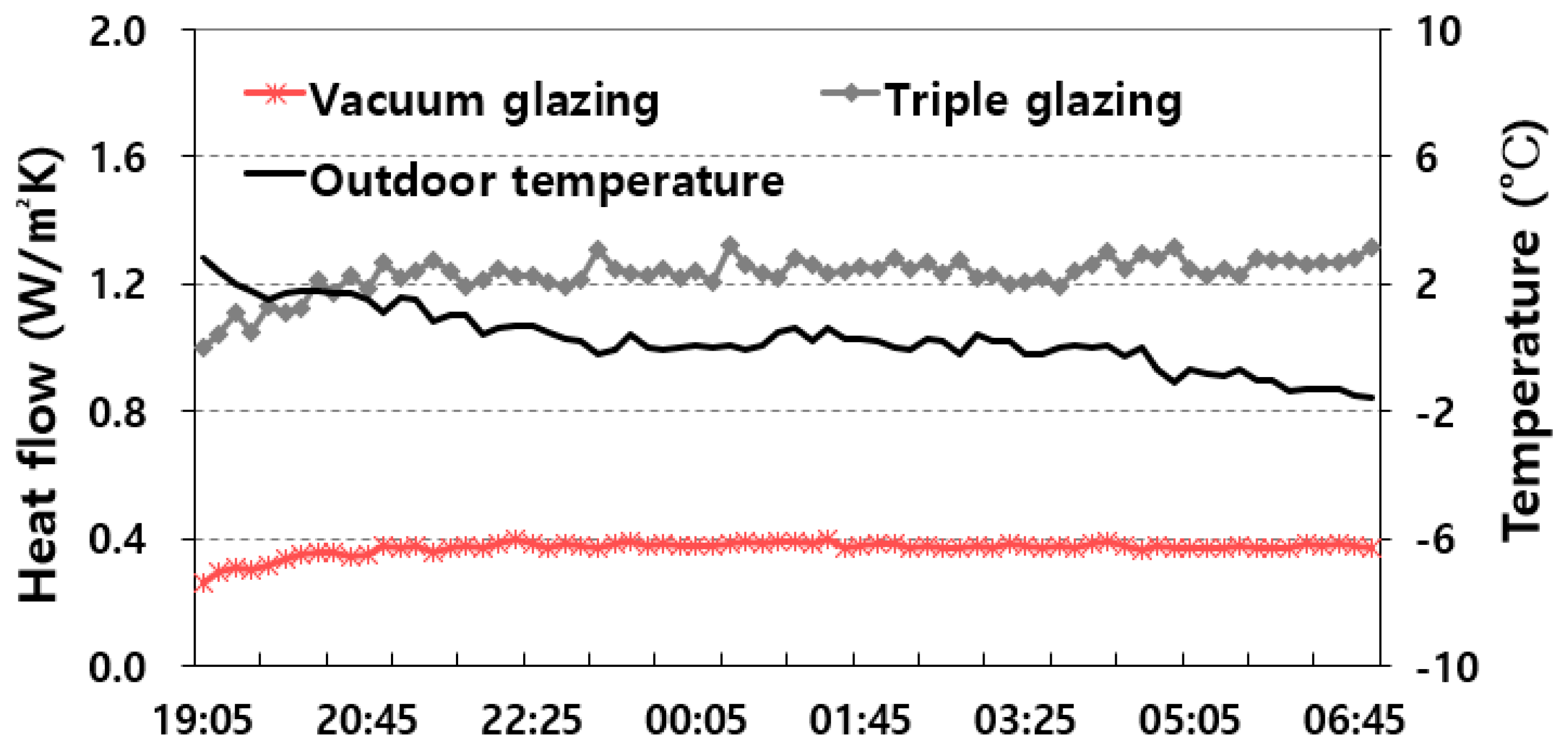



| Glazing Configuration | U-Value (W/m2K) | |
|---|---|---|
| Number of Glazing | Coating and Gas | |
| Single glazing | Clear float | 5.9 |
| One low-e coating | 5.7 | |
| Double glazing | One low-e coating and air | 1.7 |
| One low-e coating and krypton | 1.1 | |
| Two low-e coating and krypton | 1.0 | |
| Triple glazing | One low-e coating and air | 1.3 |
| One low-e coating and krypton | 0.9 | |
| Two low-e coating and krypton | 0.9 | |
| Manufacturing Method | Pumping Decompression | In-Vacuum |
|---|---|---|
| Vacuuming degree (Pa) | ~1.3–0.13 | ~0.0013–0.00013 |
| Manufacturing time (hours) | ~10–12 | ~6–7 |
| Raw material | Float glass, low-e glass (hard coating; soft coating low-e glass can be used when indium sealing material is used) | Float glass, low-e glass (hard coating, soft coating), color glass, etc. |
| Evacuation hole |  | 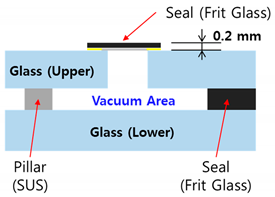 |
| Vacuum multi-layer glazing geometry | 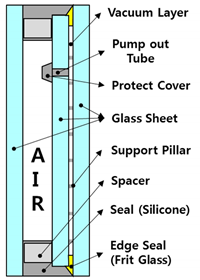 |  |
| Feature | Description | Size |
|---|---|---|
| Shape | Cylindrical |  |
| Height | 0.25 mm | |
| Diameter | 0.4 mm | |
| Projected area | 0.126 mm2 | |
| Material | Stainless Steel | |
| Placement spacing | 24 mm, 30 mm, 40 mm, 50 mm |
| Category | LE-0 | LE-2 | LE-5 |
|---|---|---|---|
| Glazing composition | 5CL + 12A + 5CL + 0.25V + 5CL | 5LE + 12A + 5CL + 0.25V + 5CL | 5CL + 12A + 5CL + 0.25V + 5LE |
| Geometry | 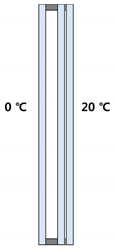 |  |  |
| Category | Thermally Broken Aluminum Frame + Vacuum Glazing | PVC Frame + Vacuum Glazing |
|---|---|---|
| Structure of the vacuum multi-layer glazing |  | |
| Specimen | 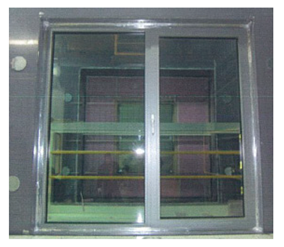 |  |
| U-value (W/m2K) | 0.866 | 0.690 |
| Item | Specifications | Location of Vacuum and Triple Glazed Windows |
|---|---|---|
| Location | Daejeon, Korea |  |
| Completion | 2009. Jul. | |
| Stories | 1 basement & 2 ground floors | |
| Structure | Reinforced concrete | |
| 1st Floor | 103.86 m2 (Living room, Kitchen, Dining room, 2 bedrooms) | |
| 2nd Floor | 55.80 m2 (Living room, 2 bedrooms) |
| Item | Vacuum-Glazed Window | Triple-Glazed Window |
|---|---|---|
| Glazing composition | 5 CL + 12 A + 5 CL + 0.25 V + 5 LE | 6 CL + 18.5 A + 3 CL + 18.5 A + 6 LE |
| Window cross-section | 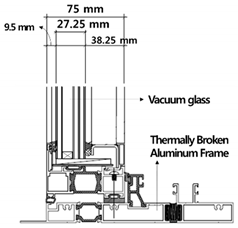 | 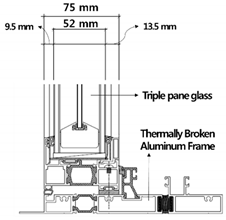 |
| Glazing Type | Temperature Sensor Installation Position |
|---|---|
| Vacuum glazing |  |
| Triple glazing |  |
© 2019 by the authors. Licensee MDPI, Basel, Switzerland. This article is an open access article distributed under the terms and conditions of the Creative Commons Attribution (CC BY) license (http://creativecommons.org/licenses/by/4.0/).
Share and Cite
Park, J.; Oh, M.; Lee, C.-s. Thermal Performance Optimization and Experimental Evaluation of Vacuum-Glazed Windows Manufactured via the In-Vacuum Method. Energies 2019, 12, 3634. https://doi.org/10.3390/en12193634
Park J, Oh M, Lee C-s. Thermal Performance Optimization and Experimental Evaluation of Vacuum-Glazed Windows Manufactured via the In-Vacuum Method. Energies. 2019; 12(19):3634. https://doi.org/10.3390/en12193634
Chicago/Turabian StylePark, Jaesung, Myunghwan Oh, and Chul-sung Lee. 2019. "Thermal Performance Optimization and Experimental Evaluation of Vacuum-Glazed Windows Manufactured via the In-Vacuum Method" Energies 12, no. 19: 3634. https://doi.org/10.3390/en12193634
APA StylePark, J., Oh, M., & Lee, C.-s. (2019). Thermal Performance Optimization and Experimental Evaluation of Vacuum-Glazed Windows Manufactured via the In-Vacuum Method. Energies, 12(19), 3634. https://doi.org/10.3390/en12193634





